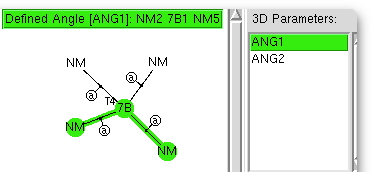I love experiments where the insight-to-time-taken ratio is high. This one pertains to exploring the coordination chemistry of the transition metal region of the periodic table; specifically the tetra-coordination of the series headed by Mn-Ni. Is the geometry tetrahedral, square planar, or other? One can get a statistical answer in about ten minutes.
 The (CCDC database) search definition required is shown above. The central atom defines the column of the period table, it is specified to have precisely four other atoms bonded to it, which can be any other element. These four bonds are specified as acyclic (to avoid any bias introduced by rings). And two angles are defined subtending the central atom. And off we go, defining on the way that the hits must be refined to an R-factor of < 0.05, have no disorder, and no errors.
The (CCDC database) search definition required is shown above. The central atom defines the column of the period table, it is specified to have precisely four other atoms bonded to it, which can be any other element. These four bonds are specified as acyclic (to avoid any bias introduced by rings). And two angles are defined subtending the central atom. And off we go, defining on the way that the hits must be refined to an R-factor of < 0.05, have no disorder, and no errors.
Archive for the ‘Chemical IT’ Category
Five things you did not know about (fork) handles.
Tuesday, March 18th, 2014OK, you have to be British to understand the pun in the title, a famous comedy skit about four candles. Back to science, and my mention of some crystal data now having a DOI in the previous post. I thought it might be fun to replicate the contents of one of my ACS slides here.
The Amsterdam Manifesto and crystal structures.
Tuesday, March 18th, 2014I have mentioned the Amsterdam manifesto before on these pages. It is worth repeating the eight simple principles:
Internet Archaeology: Blasts from the past.
Friday, October 11th, 2013In 1993-1994, when the Web (synonymous in most minds now with the Internet) was still young, the pace of progress was so rapid that some wag worked out that one “web-year” was like a dog-year, worth about 7 years of normal human time. So in this respect, 1994 is now some 133 web-years ago. Long enough for an archaeological excavation.
Publishing a procedure with a doi.
Wednesday, October 2nd, 2013In the two-publisher model I proposed a post or so back, I showed an example of how data can be incorporated (transcluded) into the story narrative of a scientific article, with both that story and the data each having their own independently citable reference (using a doi for the citation). Here I take it a step further, by publishing a functional procedure in a digital repository[cite]10.6084/m9.figshare.811862[/cite] and assigned its own doi:10.6084/m9.figshare.811862.
A two-publisher model for the scientific article: narrative+shared data.
Sunday, September 15th, 2013I do go on rather a lot about enabling or hyper-activating[cite]10.1039/P29950000007[/cite] data. So do others[cite]10.1038/nj7461-243a[/cite]. Why is sharing data important?
The Amsterdam Manifesto on Data Citation Principles
Wednesday, July 31st, 2013The Amsterdam manifesto espouses the principles of citable open data. It is a short document, and it is worth re-stating its eight points here:
150,000,000 DFT calculations on 2,300,000 compounds!
Friday, July 5th, 2013The title of this post summarises the contents of a new molecular database: www.molecularspace.org[cite]10.1021/jz200866s[/cite] and I picked up on it by following the post by Jan Jensen at www.compchemhighlights.org (a wonderful overlay journal that tracks recent interesting articles). The molecularspace project more formally is called “The Harvard Clean Energy Project: Large-scale computational screening and design of organic photovoltaics on the world community grid“. It reminds of a 2005 project by Peter Murray-Rust et al at the same sort of concept[cite]10.1007/s00894-005-0278-1[/cite] (the World-Wide-Molecular-Matrix, or WWMM[cite]10.1186/1758-2946-3-42[/cite]), although the new scale is certainly impressive. Here I report my initial experiences looking through molecularspace.org